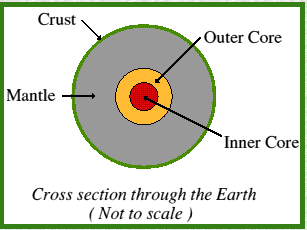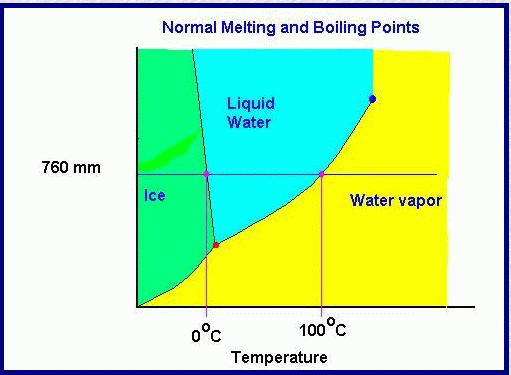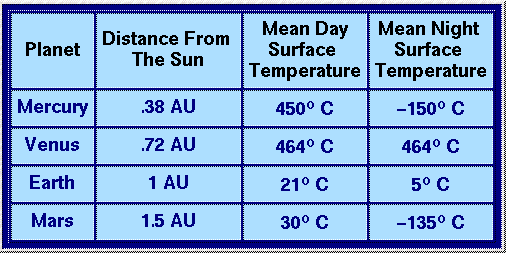 Lesson 2:
Lesson 2:
 Earth
Earth
 Planet of Life
Planet of Life
|
 2.3
2.3
 The Water Planet
The Water Planet

|
 |
Figure 2.3.1 The Pacific Ocean
|
There are (at least) two things we would like to know concerning the fact that
the home planet has an ocean and its siblings in space do not:
 What is so special about Earth that
allows it to have an ocean? What is so special about Earth that
allows it to have an ocean? |
 And how does having an ocean make
the Earth a good place And how does having an ocean make
the Earth a good place
 for Life? for Life? |
We have already identified two vital ingredients of the answer to the first
question: size and distance to the home star (or better: energy received). Are
there others? Is it important what stuff the Earth is made of? Or did Earth,
as a planet, have a history of evolution that is fundamentally different from
the histories of its siblings? To put the question within the framework of the
thought experiments of the previous section: If we put Venus in the position of
Earth, will it acquire an ocean?
Let's look at these various questions one at a time. First, we note that the mass
of the film of water on Earth, the "hydrosphere", is very small when compared to
the mass of the planet. The mass of Earth is about 6 x 1027 grams
(1027 stands for "10 multiplied by itself 27 times", that is, a 1
with 27 zeroes). The mass of the hydrosphere is about 1.5 x 1024 grams or 1:4000
(0.025%) of Earth's total mass.
This value of 0.025% is significant. It means that there is no problem in
deriving the water from the kind of planetary matter that is abundant in
the solar system. We know what this material looks like from studying the
composition of metallic and stony meteorites. On average the water content
of meteorites is well above 1:1000 (0.1%). Scientists generally agree these
meteorites are a good sample of the kind of stuff that formed the Earth, by
gravitational accretion. Thus, Earth's ocean evolved from the water expelled
from this material, as it heated up during the early history of our planet.
Whatever the exact course of events might have been during the formation of
Earth, we would have to admit that there was enough water in the primordial
meteoric matter to make the ocean.
 |
 |
Figure 2.3.2 Present day outgassing of water by Old
Faithful Geyser
Yellowstone National Park
|
This line of reasoning pretty much eliminates the likelihood that our neighbors
in space, the Moon, Venus and Mars, don't have enough water within their bodies
to make oceans.
Perhaps, then, it is a question of expelling the water from the original rock?
To check
this idea, we must look at the structure of Earth, which we shall turn to presently.
For now, we note that Earth and all its neighbors in space show the effects of
gravitational segregation, with heavy materials concentrated toward the center of
a planetary body, and light matter farthest away from the center of gravity. For
Earth, this means a heavy metallic core, a thick mantle of basaltic rock
surrounding the core, a relatively thin crust of rocks to walk on, a layer of water,
and an envelope of gas. What is especially interesting is that the mantle of Earth
(which makes up two thirds of its volume) shows "convection", like soup being heated
on a stove. Through this process, through geologic time, different parts of the mantle
come to the surface of the planet and then disappear again deep into the interior.
The convection is driven by the heat generated from decay of radioactive elements
inside the Earth. Again, size
is crucial for translating this type of heat into convection. A small planet
(such as the Moon) also has radioactive elements releasing energy, but the heat
generated can be dissipated by diffusion and does not build up sufficiently to
soften up the rocks and make things move.
 |

|
Figure 2.3.3 Internal structure of the Earth |
Now let us turn to the question of what the presence of water does for the
standard of living on Earth. The fact that water has existed in its three
phases (solid, liquid, gas) for billions of years, is of crucial
importance for the climatic conditions on Earth, and hence for the evolution
of life. Great amounts of energy can be taken up (or released) by water when
it changes phase. This property of water, and others, makes the hydrosphere
a planetary air conditioner of great efficiency.
How does this work? First, let us take a look at the properties of water
as they affect the heat budget of Earth. We already met with one important
property in connection with the "greenhouse effect": absorption of heat
radiation by water vapor. Without it, our home planet would be inhospitable
at an average temperature of near zero degrees Fahrenheit. But there is a
much more elementary question: How does water react to heating or cooling?
How much energy can it store?
 |

|
Figure 2.3.4 Phase diagram for water. The horizontal
axis is temperature, the vertical axis is pressure.
Freezing and boiling temperatures are indicated for
760 millimeters of mercury which is normal atmospheric
pressure at sea level.
|
It turns out that water is much more efficient in storing heat than any
other common substance on Earth. To increase the temperature of fluid water
by one degree Centigrade takes one calorie of heat energy for each gram of
water. To do the same for a rock, for comparison, takes 0.2 calories per gram,
and for petroleum, 0.5 calories per gram. To change a gram of ice into water
(without increasing the temperature) takes 80 calories. Conversely, when water
freezes, it releases this amount of heat into the environment. To change a
gram of water into vapor takes 580 calories! This means that evaporation is
the best cooling mechanism around. Our body takes advantage of this fact when
cooling itself by sweating: The evaporation of the sweat extracts heat from
the surroundings, lowering the temperature of the skin. The heat expended in
the phase change of water to vapor is not lost, but is contained in the vapor
in latent form. For this reason, this energy is called "latent heat". When
the vapor condenses, the heat is freed for warming the surrounding air.
This process can be observed when a thunder storm develops: the newly forming
clouds release heat to the air and the heated air rises to make more clouds.
The phase changes of water, combined with the unique heat-related properties
of water, are intimately involved in all aspects of climate and weather.
Water transfers and stores heat on an immense scale, and thereby evens out
the temperature differences between day and night, summer and winter,
tropics and polar areas. It is in this fashion that water makes Earth a
nice place to live, even for those creatures (like us) who do not have
the benefit of being immersed in water.
 |
Table 2.3.1 Comparison of surface temperatures for the
terrestrial planets. |
Consider the temperature differences between day and night. They
are largest in the water-starved desert. In areas where water is
abundant, evaporation during the day tends to lower the temperature,
and condensation during the night (the familiar dew) tends to raise
it. During the day, clouds protect the ground from the heat of the
Sun, and at night, from the black coldness of space. Seasonal
differences are similarly tempered by the great heat reserves of
water, hence the mildness of coastal climates. Likewise, geographic
differences are moderated by the transfer of heat through water
motion and water phase changes. Most of this transfer is by water
vapor in the air. Warm winds blowing over warm ocean regions
pick up the water, cooling the sea surface. In cold regions, the
air becomes unable to hold the vapor. The vapor condenses and
gives off its heat of evaporation. If it freezes to snow, it also
gives off its heat of fusion, to the surrounding air. Thus, a
blizzard brings warmth -- a somewhat unexpected conclusion,
perhaps, to those who have been surprised by a snowstorm during
a hike in the mountains.
Ocean currents also play an important role in transferring heat
from the warm tropics to the cold polar regions. A familiar example
is the relatively mild climate of Norway, which depends upon the
warm waters brought north along the Norwegian coast through an
extension of the Gulf Stream System. Excepting the poles, the most
severe climates are in the interior of continents, far from the
sea. Central Siberia is the prime example of a "continental"
climate with great seasonal temperature contrasts.
|





















